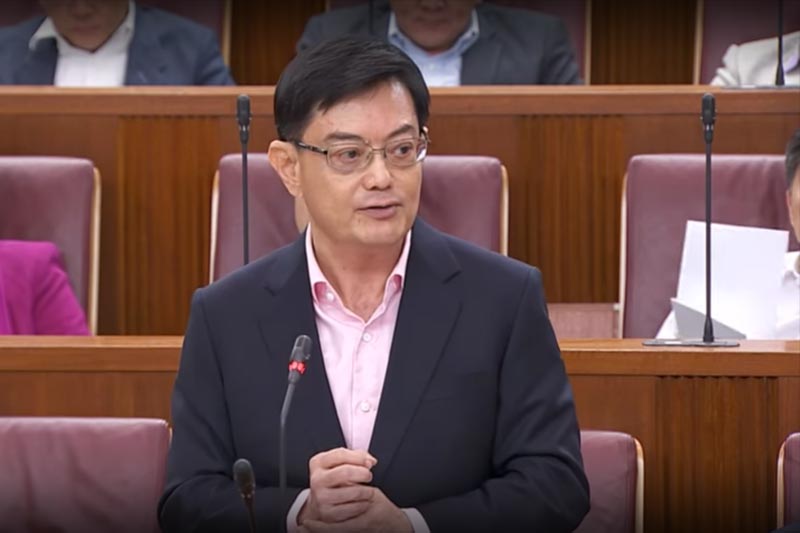
Singapore’s Minister for Finance, Mr Heng Swee Keat presented the Government’s FY18 Budget today. In the Budget speech Minister Heng highlighted three major shifts in the coming decade that Singapore needs to prepare for.
First is the shift in global economic weight towards Asia, in view of China’s Belt and Road initiative, India’s economic reforms and a rapidly growing middle class in ASEAN countries, in conjunction with Brexit and the US’ recent tax changes and review of trade pacts. The second major shift is the emergence of new technologies, leading to the rise of Industry 4.0 and firms competing increasingly not on physical assets, but on intangible assets, such as intellectual property (IP), data, and user networks. The final shift Minister Heng talked about is ageing, driving a significant increase in healthcare and social expenditure and a shrinking resident workforce.
Interactions between these three shifts are expected to create opportunities as well as challenges. For instance, technology would help older workers to stay productive, and assist caregivers to care for seniors. At the same time, the rapid pace of technological change may lead to older workers feeling marginalised.
To benefit from the opportunities and address the challenges, the Budget includes a number of measures directed towards developing a more vibrant and innovative economy, along with building a smart, green and liveable city, fostering a caring and cohesive society and planning ahead for a fiscally sustainable and secure future.
The launch of the Industry Transformation Maps (ITMs; 21 of the proposed 23 ITMs have been launched) is a start towards development of an innovative economy. Minister Heng said that a more cluster-based approach will be adopted for the next phase of the ITM journey, to leverage synergies and strengthen linkages across multiple industries. Three key enablers form the foundation of the ITMs: innovation, capabilities and partnerships.
Helping firms innovate
The Government will support more firms to innovate across the entire value chain– in buying new solutions, building their own, or partnering others to co-innovate.
The Government will streamline existing grants supporting the adoption of pre-scoped, off-the-shelf technologies into a single Productivity Solutions Grant (PSG). In addition, the tax deduction on licensing paymentsfor the commercial use of intellectual property (IP) will be raised. With the expiry of the Productivity and Innovation Credit (PIC) scheme, the tax deduction on licensing payments has reverted to 100% for YA2019 and beyond. This will be raised 200%, capped at S$100,000 of licensing payments per year.
To support businesses to build their own innovations, the tax deduction for IP registration fees will be increased from 100% to 200%, to help firms protect their intangible assets. This will be capped at S$100,000 of IP registration fees per year. The tax deduction for qualifying expenses incurred on R&D done in Singapore is also being raised from 150% to 250%.
The Government is also planning to pilot an Open Innovation Platform this year to help businesses find partners for co-creation of solutions. This is a virtual crowd-sourcing platform, where companies can list specific challenges that can be addressed by digital solutions. They will then be matched with info-communications and technology (ICT) firms and research institutes, to co-develop solutions.
Mark Micallef, vice president, Asia Pacific & Japan, Cloudera, commented, “The Open Innovation Platform (OIP) initiative directly tackles the challenges faced by businesses that are keen to embark on a digital transformation journey but are constrained by current resources and shrinking budgets. As Singapore strives for a digital economy, businesses are expected to ride the wave of disruptive technologies to stay ahead. For example, Financial Services Institutions (FSIs) and telecommunications service providers are increasingly tapping on the colossal volumes of data to extract rich insights that can help deliver enhanced and personalised offerings to customers. OIP is a much needed collaborative industry ecosystem that can offer businesses new ways to stay relevant and competitive without overwhelming existing resources. By tapping on external expertise and solutions delivered through OIP, businesses are given a much needed boost to accelerate their digital transformation. The OIP can also empower companies to invest in the latest technologies such as machine learning, analytics, and cloud to better prepare for the future economy. This initiative is a great example of how public and private sectors can come together to collectively achieve Singapore’s vision of building a Smart Nation by 2020.”
New NRF-Temasek IP Commercialisation Vehicle
The Singapore Government has taken a number of initiatives in recent years to translate public sector research efforts into commercially viable applications.
This year the National Research Foundation (NRF) and Temasek will launch an NRF-Temasek IP Commercialisation Vehicle. The new investment venture will bring together Temasek’s global investment networks and NRF’s connections with the Singapore R&D community, to grow companies that draw on IP from publicly-funded research. At least S$100 million will be invested into this joint venture – S$50 million from the Government, and at least S$50 million from Temasek.
S$500 million for Aviation and Maritime Transformation Programmes
To strengthen Singapore’s status as an air and sea hub, an Aviation Transformation Programme (ATP) and a Maritime Transformation Programme (MTP) will be launched during 2018.
Through these programmes, Singapore’s airport and seaport will become platforms for companies to develop, test and use new technologies. These solutions can then be rapidly adopted in other parts of Singapore, or even exported overseas. The Government will provide support of up to $500 million for the two programmes, with additional matching investments expected from industry partners.
Expanded National Robotics Programme
To improve labour productivity, the Government will expand the National Robotics Programme (NRP), to encourage wider use of robotics in the built environment sector, particularly in construction.
The National Robotics Programme was announced in 2015 to develop robotics technologies for applications in various industry verticals for addressing national challenges such as an ageing population. It received an infusion of S$450 million in 2016 for scaling up over the next three years.
More targeted support to help firms build capabilities
In April, SPRING and IE Singapore are going to merge into a single entity, Enterprise Singapore.
Enterprise Singapore will provide integrated support to companies, for internationalisation as well as the development of other capabilities, so as to help them compete better both locally and abroad.
IE’s Global Company Partnership grant will be combined with SPRING’s Capability Development Grant, to form an integrated Enterprise Development Grant (EDG). The EDG will provide up to 70% co-funding for companies to build a range of capabilities.
The Government will enhance the Double Tax Deduction for Internationalisation (DTDi) to further support firms to internationalise. The amount of expenses that can qualify for the DTDi without prior approval, will go up from $100,000 to $150,000 per year of assessment, effective from YA2019.
This year, the Government is studying, with the Singapore Business Federation (SBF) and other industry partners, the development of a nationwide e-invoicing framework. This can help companies improve productivity and enhance cash flow.
S$145 million for Tech Skills Accelerator over next 3 years
Since the Government launched the Tech Skills Accelerator (TeSA) in 2016, over 27,000 training places have been taken up or committed. TeSA offers various programmes to support current information and communications technology (ICT) professionals and non-ICT professionals to upgrade and acquire new skills and domain knowledge that are in demand, and to stay competitive and meet the challenges of a fast-moving digital landscape.
TeSA will be expanded into new sectors like manufacturing and professional services, where digital technologies are increasingly important. TeSA will also support more people to learn emerging digital skills, such as in data analytics, artificial intelligence, the Internet of Things and cybersecurity.
An additional S$145 million is being set aside for TeSA over the next three years.
JY Pook, Senior Vice President, Asia Pacific, Tableau Software, welcomed the announcement saying, “Data analytics has been highlighted as one of the most sought after skills in a market where the demand for talent with technical capabilities is increasing. At the same time, businesses are undoubtedly realising the value in harnessing insights from their data to make better decisions – but these decisions need to be quick to keep up with the pace of change today. The demand points towards a need for analytics at scale; where more people, not just data specialists, are able to use self-service analytics to make faster decisions and have a higher impact at their jobs. Providing the right data tools and skills will make Singapore’s workforce more productive, while businesses will be able to keep pace with the constantly evolving business landscape.”
Integrated Enterprise Development Grant to help firms build capabilities
With the merger of SPRING and IE Singapore into Enterprise Singapore in March, IE’s Global Company Partnership grant will be combined with SPRING’s Capability Development Grant, to form an integrated Enterprise Development Grant. The EDG will provide up to 70% co-funding for companies to build a range of capabilities.
Integrated PACT scheme to support partnerships
The Government will continue to encourage Singapore companies to form strong partnerships, both locally and abroad. Various partnership support measures will be integrated into a single PACT scheme.
Under PACT, companies can receive up to 70% co-funding, for projects undertaken in partnership with others.
The Government is setting aside S$800 million over the next three years for PACT, the Productivity Solutions Grant and the EDG.
S$250 million for 3 urban solutions and sustainable development R&D programmes
The Government will invest S$250 million in the Cities of Tomorrow R&D programme, Closing the Waste Loop project and the development of Energy
Grid 2.0.
The Cities of Tomorrow programme was launched in 2017 with an allocation of S$150 million to drive innovation in urban development. The Programme focuses on three key R&D areas: Advanced Construction and Resilient Infrastructure; creating New Spaces; and providing a high-quality and sustainable living environment for all Singaporeans.
Last year, the National Environment Agency (NEA) launched the Closing the Waste Loop research funding initiative to boost Singapore’s R&D capabilities in developing solutions to extract value and resources from key waste and residue streams including plastics, food, electrical and electronic products, and incineration ash. The initiative is supported by the NRF and the Ministry of National Development (MND) under the Research, Innovation and Enterprise 2020 Plan (RIE2020), with a funding of S$45 million under the Urban Solutions and Sustainability (USS) domain.
This year, Singapore will embark on Energy Grid 2.0. Grid 2.0 refers to the next-generation grid system that will transform how energy is managed by consolidating gas, solar and thermal energy into a single intelligent network that is more efficient, sustainable and resilient.
This builds on Singapore’s past investments in smart meters, grid storage, solar photovoltaics, as well as various energy efficiency and demand management solutions to address Singapore’s unique energy challenges, and also grow the base of capabilities.
















